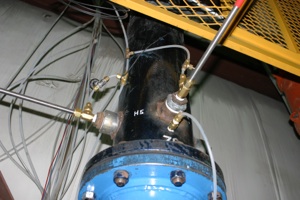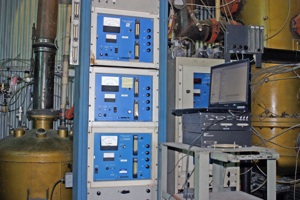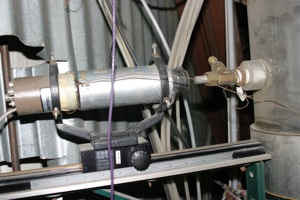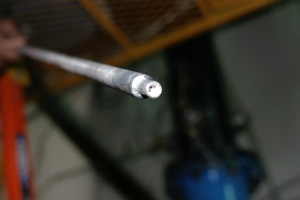 |
Static Electric Probes These probes measure the amount of static buildup in either bubbling/turbulent fluidized beds or risers. |
 |
Bubble Probes PSRI has developed optical probes to measure the size, velocity and frequency of bubbles/voids in both bubbling and turbulent fluidized beds. PSRI has also developed the associated electronics and software required to determine bubble characteristics in fluidized beds. |
 |
Solids Concentration Probes Optical concentration probes are also available to measure particle concentration in either dense beds or dilute risers. |
 |
Gas Tracer Probes These probes are inserted into the bed to measure gas tracer profiles and determine gas dispersion in beds. The tracer gas is usually helium, and PSRI uses a thermal conductivity analyzer to detect the helium concentration at various heights and radial locations in the beds. |
 |
Gamma-Ray Densitometer Probe PSRI also uses a gamma-ray densitometer to measure the density of particles in a fluidized bed. This probe is approximately a sixth-generation probe that has undergone repeated improvement. It uses various low-power, gamma-ray sources to increase the sensitivity of the probe. |
 |
Particle Extraction Probes Suction probes are used to measure the mass flux at axial and radial locations in a fluidized bed riser. PSRI has been using these probes for over 10 years, and has supplied many of these probes to member companies. |
|
Optical Fiber Particle Mixing Probes PSRI has also developed its own particle mixing probes and techniques. The probes work in conjunction with a fluorescent solids tracer. In this technique, coated fluorescent particles are injected into a bed. The fluorescent tracer is coated on the particles that will actually be in the bed (FCC catalyst, polyethylene, etc.). A matrix of probes is inserted into the bed. Typically, nine probes (3 probes located 120-degrees apart at three levels in the bed) are placed in the bed. Each probe has an optical fiber that transmits UV light into the bed. When the UV light strikes a particle coated with the fluorescent material, the particle gives off visible light that is transmitted back to sensors through a second optical fiber. This allows the concentration of the fluorescent particles in the bed to be determined as a function of time, and also allows mixing times and patterns to be distinguished. |
|
|
Acoustic Probes Both ultrasonic transducers and accelerometers are used to measure particle and bubble events, respectively. Ultrasonic waveforms can provide both particle loading and velocity information. The lower frequency accelerometers provide bubble hydrodynamics, fluidization quality, and gas bypassing data. Both types of probes can be externally mounted to the unit. |
|
PSRI Specially Designed Probes
©
1971 - 2023
Particulate Solid Research, Inc
PSRI Restricted: Authorized Access Only

